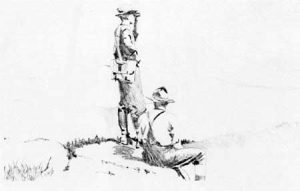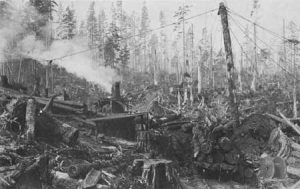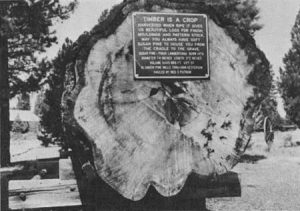THE CONSERVATION MOVEMENT GROWS 1898-1917

Around 1900, the forest conservation movement began to expand greatly under the dynamic leadership of Gifford Pinchot. Pinchot brought the word "conservation" into popular usage in its application to natural resources. The next two decades saw the establishment of a forestry profession. The Forest Service came into being. The National Forest System was developed and expanded.
1898 Gifford Pinchot was named head of the Forestry Division in the Department of Agriculture with a staff of 12 persons, 6 for clerical and 6 for scientific work. Within 7 years the number of employees had increased to more than 700, many of them graduates of the newly established forestry schools. It was in 1898 that the first fieldwork was done by U.S. forestry employees. The fieldwork consisted of special investigations in connection with lumbering. Mr.Pinchot, with great energy and leadership, enlarged and extended thescope of the Division of Forestry beyond the confines of the office to make it a vital and useful service.
The first 4-year professional curriculum in forestry was started at Cornell University in New York. In the same year the Biltmore Forest School, a private school, was started in North Carolina.The Yale Forest School was established in 1900, offering a graduate curriculum in forestry leading to a master's degree. During the next 5 years, regular forestry curricula were started at the Universities of Michigan, Maine, Nebraska, and Minnesota, the State Forest Academy at Mont Alto, Pa., and Colorado College. Harvard University set up an undergraduate curriculum in 1903, but later moved its forest work to the graduate school. Before 1905, Michigan and Iowa State Colleges also were offering nonprofessional courses that later were expanded into full professional curricula.
The first farmers' bulletin on forestry was issued,entitled "Forestry for the Farmers."
The General Land Office grouped the forest reserves into 11 districts, each headed by a superintendent. Each reserve was under the direction of a supervisor, who was assisted by rangers who conducted forest patrols, forest protection, and other work.

Figure 15.—Barking logs prior to loading—Snoqualmie National Forest, Wash. F—95417
1899 The act of February 28 provided for recreational use of the reserves. This was the first of such laws to recognize the value of the forests for recreation. Later laws extended the uses permitted and provided for regulations to keep the facilities always available to the people.
Minnesota set up a State forestry board, and designated as forest reserves all tracts set aside or acquired by theState or donated to the State for forestry purposes.
Michigan set up a State forestry commission.
Mt. Rainier National Park was established in Washington State on 239,892 acres taken from the Pacific Forest Reserve.
1900 The Society of American Foresters, a professional organization of technically trained foresters, was founded.
1901 The Division of Forestry in the Department of Agriculture became the Bureau of Forestry with authority to engage in a variety of work, including the making of forest plans for private timber land owners, tree planting, and forest investigations(act of March 2, 31 Stat. 929).
A Forestry Division was set up in the General Land Office, headed by Filibert Roth, who had served for some time under Dr. Fernow in the Department of Agriculture's Division of Forestry. Mr. Roth was the first trained forester employed regularly in the Department of the Interior. He was assisted by three other trained foresters. However,all four resigned in 1903.
At the special request of the Secretary of the Interior, a trained forester was detailed from the Department of Agriculture to the Interior Department. He prepared the first Government timber sale contract in the United States covering the proper removal of timber from Federal forest reserves, in the Black Hills of South Dakota.He then was a special agent of the Secretary of the Interior for about a year inspecting and reporting on forest conditions and activities on other forest reserves throughout the West.
A special act was passed by Congress authorizing the Grand Portage Indians to sell timber from their allotted lands. Similar acts were passed in rapid succession for other Indian lands. The next year an act of Congress specified that 5 percent of the timber on theChippewa Indian Reservation be left standing for forest renewal purposes, and that cutting be restricted to pine.
The annual report of Secretary of the Interior Hitchcock recommended placing the forest reserves in the Department of Agriculture under the control of the Bureau of Forestry.
Walter Mulford was appointed State Forester of Connecticut, first State forester in the United States. A few weeks later George Wirt became State Forester in Pennsylvania.

Figure 16.—"High wheels" and locomotive formerly used for logging in Wisconsin. F—380138
1902 The first forest reserve created by Congress and not by Presidential proclamation, the Minnesota ForestReserve, was set up.
Crater Lake National Park was created in Oregon from156,850 acres of the Cascade Forest Reserve.
1901-05 Agitation for transfer of the forest reserves to the Department of Agriculture was continued. President Theodore Roosevelt sent messages to Congress urging the transfer. The American Forest Congress, meeting in Washington in 1905, passed a resolution calling upon the U.S. Congress to unify all forest work of the Government, including the National Forests, in the Department of Agriculture. At this meeting, President Roosevelt declared that the object of forestry is not to "lock up" forests but to consider "how best to combine use with preservation."
1904 Louisiana became the first southern State to set up a State Department of Forestry and a forest fire warden system.
1905 The act of February 1 (33 Stat. 626)provided for the transfer of forest reserves from the Department of the Interior to the Department of Agriculture. The present Forest Service dates from this act. The Agricultural Appropriation Act of March 3 (33 Stat. 872), effective July 1, designated the old Bureau of Forestry as the Forest Service. When the Forest Service took charge of the forest reserves they numbered 60, with a net acreage of some 56 million acres of land actually owned by the Government. Forest Service personnel numbered 734, of whom 268 were in the Washington office and 466 in the field service.
North Carolina and California each created the office of State Forester.
Tennessee established the Department of Game, Fishand Forestry.

Figure 17.—Dedication of the first piece of land purchased under the Weeks Law, an 8,100-acre tract near Marion, N.C. F—500024
1906 The act of June 11 (34 Stat. 233)provided that those lands within forest reserves chiefly valuable for agriculture be listed for homestead and entry purposes. Under this act a huge program of land classification was carried out and several million acres of land withdrawn from the National Forest reserves. Under earlier homestead acts there had been a great deal of fraud and much land was taken for homesteads that should have been left in forest. This happened again.
The area of forest reserves was increased to 106,999,138 acres; timber sales tripled over the previous year; and grazing fees were charged, although the first grazing permits were issued in 1897 for horses and cattle; and in 1902 for sheep. An act was passed June 8, to preserve American antiquities or features of scientific or historical interest situated upon land owned or controlled by the Government. These areas are known as National Monuments, and are administered by the Department of the Interior. Many of these areas were under Forest Service control until transferred to the Department of the Interior in 1933.
Maryland set up a State Board of Forestry empowered to employ a trained forester to head the State forest fire protection system and direct all State forestry interests. Maryland also provided for purchase of State forest reserves.
Kentucky set up a State Board of Agriculture,Forestry and Immigration.
1907 A western element in Congress, opposed to the National Forest enterprise, succeeded in attaching to the agricultural appropriations bill a rider prohibiting any further additions by Presidential proclamation to the forest reserves in Oregon,Washington, Idaho, Montana, Colorado, and Wyoming. President Theodore Roosevelt signed the bill carrying the rider to be effective March 4,but before he did so on March 1 and 2 he signed 33 proclamations by which new reserves were created and areas added to already established reserves so that a total of 15,645,631 acres was added to the forest reserve system. California was added to the restricted list in 1912, and Arizona, and New Mexico in 1926. Addition to the National Forests or creation of new ones in these States can be only by action of Congress.
The name "forest reserves" was changed to "National Forests." The word "reserve" implies that the area is withdrawn from use, which has not been true of these areas since 1897.
President Roosevelt appointed the Inland Waterways Commission. In its first report it emphasized the interlocking character of the problems of natural resources. It pointed out that the control and use of water would conserve coal, iron, and the soil, and in order to control water, it is necessary to preserve the forests.
Alabama set up a State Commission of Forestry.
1908 To bring administration of fieldwork closer to the forests, six district offices of the Forest Service were created, each under a district forester. Headquarters are at Missoula, Mont., Denver, Colo., Albuquerque, N. Mex., Ogden, Utah, San Francisco,Calif., and Portland, Oreg. District offices were created later at Philadelphia, Atlanta, Milwaukee, and Juneau, Alaska.
The first forest experiment station was established on the Coconino Plateau in Arizona. Other stations were soon established in Colorado, Idaho, Washington, California, and Utah.
The act of May 23 (35 Stat. 251) provided that 25 percent of all money received by National Forests (for grazing permits,sale of timber, or other special uses or products) should be paid to the States for the benefit of the public schools and public roads of the counties containing the National Forests.
President Theodore Roosevelt held the White House conference of governors to consider that our natural resources were being consumed, wasted, and destroyed at a rate that threatened them with exhaustion. Means of saving our resources were discussed, and a commission was appointed to study them. This National Conservation Commission was divided into four sections—minerals, waters,forests, and soils—with Gifford Pinchot as chairman. An inventory was published in 1909.
1909 The North American Conservation Conference was held in Washington. Statements of principles of conservation for the North American Continent were adopted.
The Western Forestry and Conservation Association was established by western lumbermen.
By this year, 11 States owned and administered nearly 3 million acres of State forests: Connecticut, Indiana, Maryland,Massachusetts, Michigan, Minnesota, New Hampshire, New Jersey, New York,Pennsylvania, and Wisconsin. Of this total, 1,611,817 acres were in New York State, 863,000 in Pennsylvania, and 253,573 in Wisconsin.
1901-09 During President Theodore Roosevelt's administration more than 148 million acres were added to the National Forests. The net increase was, however, 132 million acres since much was reclassified as farmland and opened to homesteading 1910. In June the Forest Products Laboratory was established by the Forest Service in cooperation with the University of Wisconsin at Madison, Wis. This laboratory was the first of its kind, and has become the world's outstanding institution for the scientific study of wood and its uses.Studies are constantly in progress to find new products to be made from wood; to solve problems of manufacture of wood products; to find ways to make use of wood material now wasted and to use the less favored trees;to improve methods of sawing, drying, and preserving lumber; and to find the answers to many other problems concerning wood.
An act was passed authorizing the President to reserve public lands for water power sites or irrigation. Permits water power development on Government land had been issued since 1898,but this law recognized that some areas should be set aside particularly for their water.
The great forest fires in Idaho and Montana burned over 3 million acres and cost the lives of 85 men, 74 of whom were firefighters. The worst came on August 20, when a hurricane arose and fanned and drove the raging flames at great speed. Settlers were hastily loaded on trains and carried to safety, sometimes over bridges and trestles already afire. Many feats of heroism were performed, but the most outstanding was that of Ranger Edward Pulaski, who saved all but 6 of his crew of 45 firefighters when they were trapped by the fire, by leading them to an abandoned mine tunnel.
The Indian Forest Service was set up in the Department of the Interior with three technically trained men to oversee commercial forest and woodland on Indian lands. Congress enacted the first general law authorizing the sale of live timber from tribal and allotted Indian lands.
Glacier National Park was established in Montana with 957,365 acres from the Blackfoot National Forest.

Figure 18.—Large sugar pine log on a skid sled, Collier State Park,Oreg. F—500271
1911 In the Weeks law (act of March 1, 36 Stat. 961) a new national policy was established—the purchase by the Federal Government of forest lands necessary to the protection of the flow of navigable streams. Most of the National Forests east of the Great Plains, where there was little land left in the public domain,were acquired by purchase of lands under this act and acts amending it.Certain National Forests in Alabama, Arkansas, Michigan, Minnesota,Nebraska, Oklahoma, and Florida originally were established from land still in the public domain, but additions were made by purchase. The Weeks law also established a program of Federal-State cooperation in fire protection, later expanded under the Clarke McNary law of 1924.
1912 An act (37 Stat. 269, 288) provided that 10 percent of all forest receipts for the fiscal year 1912 should be used for roads and trails within the National Forests in the States from which the receipts came. The next year (37 Stat. 828, 843) this arrangement was made permanent. The need for roads and trails were tragically shown by the terrible fires of 1910, many of which might have been stopped before they became dangerous if there had been roads by which the firefighters could reach the fires quickly.
1914 The Eastern National Forest District was established by the Forest Service. Headquarters were at Washington,D.C., but were moved to Philadelphia in 1941. Agitation for forest reserves in the East had begun as early as 1899.
1915 The term lease law was passed by Congress, authorizing issuance of term permits on National Forests for summer homes, hotels, stores, and other structures needed for recreation or public convenience.
Rocky Mountain National Park was created in Colorado from 217,091 acres of the Arapaho and Colorado National Forests.
1916 The act of July 11 appropriated $10 million "for the survey, construction, and maintenance of roads and trails within or only partly within the National Forests, when necessary for the use and development of resources upon which communities within and adjacent to the National Forests are dependent." This was in addition to the 10 percent of receipts set aside by the law passed in 1912.
Congress passed the act creating the National Park Service in the Department of the Interior.
Congress passed the Revestment Act, sometimes called the Chamberlain-Ferris Act, providing for the revestment to the Federal Government of title in 2,830,182 acres of land held by the Oregon and California Railroad granted to it for the purpose of aiding in the construction of a railroad from Portland, Oreg., to the northern boundary of California.
The Red Lake Indian Forest of almost 110,000 acres was created within the Red Lake Indian Reservation in Minnesota.

